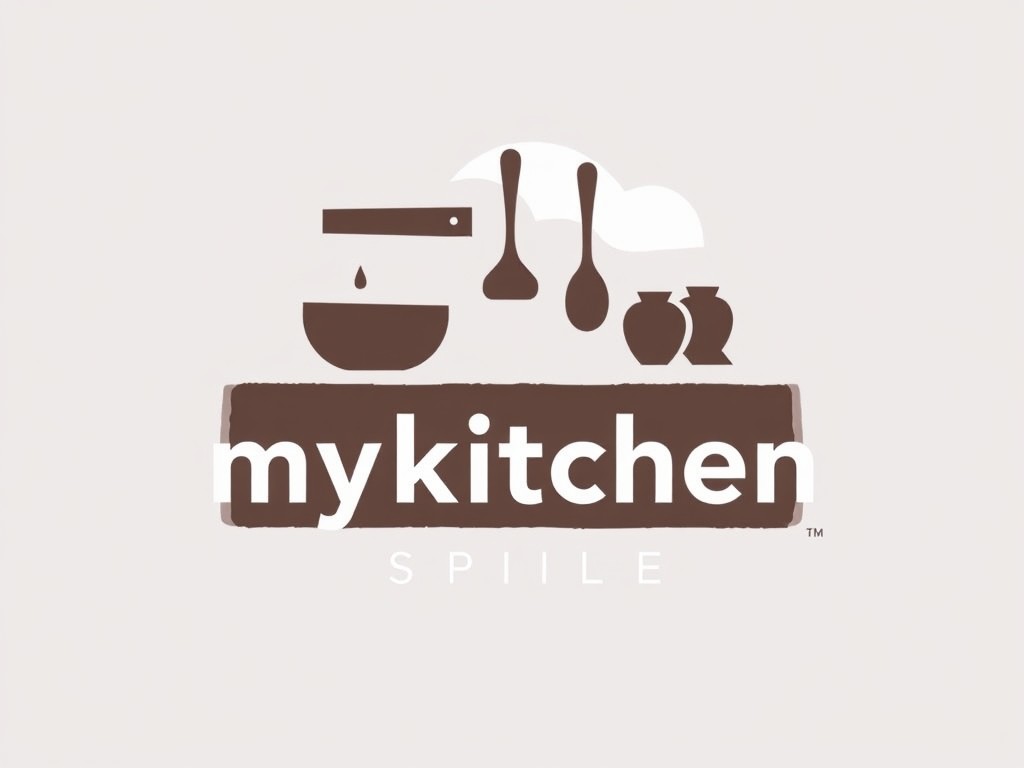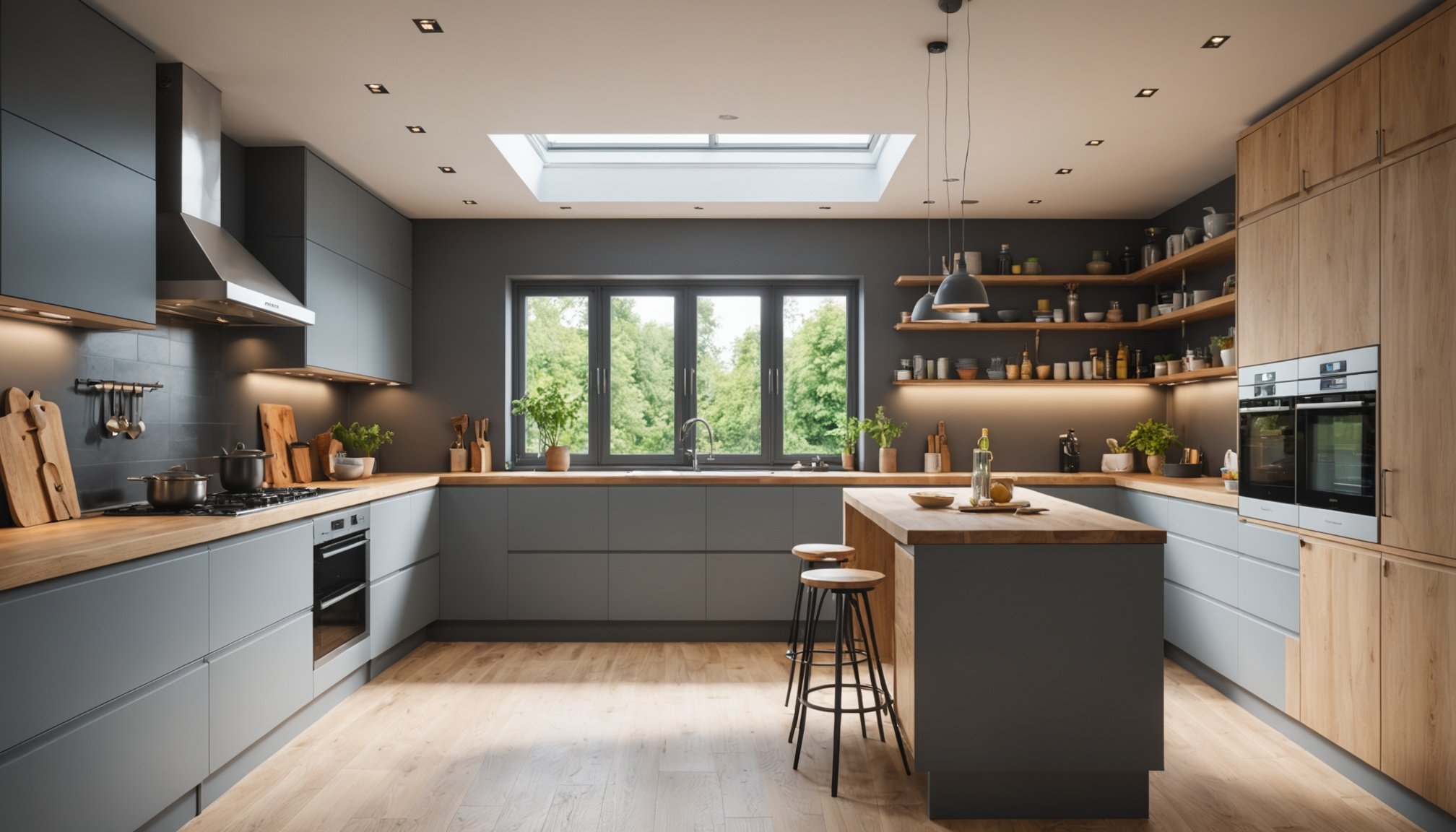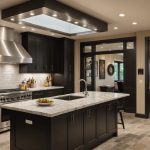Understanding Natural Light in Compact Kitchens
The presence of natural light in kitchen design significantly enhances both aesthetics and functionality. In compact kitchens, this is even more crucial, as limited space requires strategic planning to maximise light and create an inviting atmosphere. Sunlight filtering into a small area not only visually enlarges the space but also uplifts the mood and reduces electricity usage.
Compact kitchen designs often face the challenge of inadequate access to natural light due to their size and location. Many are tucked in so that windows are minimal or absent. Creative solutions such as installing skylights, using reflective surfaces, or opting for glass-fronted cabinets can help channel more light into these compact spaces.
Have you seen this : Top UK Toasters Perfect for Toasting Artisanal Breads: A Comprehensive Guide
The benefits of integrating natural light into small kitchens are manifold. Enhanced lighting can improve cooking safety by providing clear visibility of work surfaces. Moreover, natural light brings out the natural colours of food, making meal preparation a more enjoyable experience. It fosters a cheerful environment that encourages productivity and leisure.
In summary, the clever use of natural light in compact kitchens can transform a constrained area into a vibrant hub. Simple design adjustments can play a pivotal role in achieving this transformation.
Also to discover : Ultimate guide to choosing durable kitchen sink materials for your uk home
Design Elements to Enhance Natural Light
In the realm of kitchen design elements, achieving bright interiors is often a top priority. A strategic approach involves considering open shelving versus closed cabinetry. Open shelving allows light to flow freely, enhancing light enhancement by reducing barriers that block natural light. This open structure not only fosters a spacious feel but also provides the added benefit of more accessible storage.
Conversely, closed cabinetry may restrict light flow, though it offers a more streamlined appearance. Choosing between these two depends on balancing aesthetics and functionality, tailored to individual needs.
Reflective surfaces also play a significant role in maximizing light. Incorporating materials like glossy tiles, stainless steel, or glass can dramatically boost light distribution. These surfaces mirror the incoming light, creating an illusion of a larger, brighter space.
Kitchen design elements like these can transform a dim cooking area into a lively, vibrant space. Select features with reflective properties to ensure every room corner benefits from available light. Through careful planning, your kitchen can become a model of light enhancement, combining practicality with style.
Strategic Color Choices
When considering color choices for your home, selecting light hues can significantly transform the perception of a space. Opting for lighter shades, such as soft pastels or whites, can create the illusion of a larger area. This is particularly beneficial in compact rooms where space is limited. Light colors work their magic by maximising light reflection, which enhances brightness and contributes to a more open and inviting atmosphere.
Moreover, the paint selection influences more than just color; the finish also plays a crucial role in how light interacts with your walls. For example, high-gloss finishes are known for their reflective qualities, bouncing light around a room and accentuating space. In contrast, matte finishes absorb light, which might be more suitable for creating warm, cozy environments where space isn’t a concern.
By understanding these variances, homeowners can strategically harness color and finish options to sculpt their desired ambiance. This comprehension empowers individuals to make informed decisions, thereby enhancing their living spaces effectively. Remember, the right combination of color choices and finishes can drastically alter not only a room’s aesthetic but also its entire feel.
Window Treatments for Optimal Light
When considering window treatments for your UK home, choosing the right options can significantly influence your natural light management. One effective strategy is to opt for sheer curtains or blinds. These allow natural light to flow while maintaining privacy. In small kitchens, where space is limited, this choice can transform the room’s ambiance, making it feel larger and more welcoming.
Selecting appropriate window treatments also involves thoughtful window placement. For instance, in a small kitchen, positioning windows on the east side can capture morning light, which is softer and more inviting. This strategic placement maximises sunlight exposure throughout the day.
It’s important to explore materials and styles that complement your home’s interior. Light-coloured, airy fabrics are ideal for sheer curtains, while blinds come in various patterns that can enhance your room’s aesthetic. Moreover, adjustable blinds enable customisation of light levels, allowing you to adapt to the changing UK weather.
By carefully choosing and placing your window treatments, you can not only improve light management but also elevate the overall atmosphere of your home, making each room more functional and visually pleasing.
Layout Strategies for Light Optimization
When considering a kitchen layout, effective space planning plays a critical role in maximizing natural light. One fundamental principle is the impact of room arrangement on light access. A well-designed layout can transform how light travels through the space, making it feel more inviting and open.
To optimise light, it’s essential to evaluate the direction and size of windows, as well as the position and arrangement of kitchen elements such as countertops and cabinetry. Positioning the sink or workstations near windows can enhance visibility and create a pleasant atmosphere.
Space planning benefits significantly from open floor concepts. Incorporating kitchen islands not only provides additional workspace and storage but also reduces visual barriers, allowing light to permeate more evenly. Open floor plans merge the kitchen with living areas, enabling natural light to reach more corners of the space and improving overall brightness.
Integrating reflective surfaces like glossy tiles, sleek countertops, and metallic accents into the kitchen layout can further enhance light distribution. These elements bounce light across the room, minimising shadows and dark spots. Effective space planning leads to a well-lit, functional, and stylish kitchen that capitalises on the available light.
Incorporating Technology and Materials
Incorporating advanced kitchen materials and smart technologies can significantly enhance both the aesthetics and functionality of your space. Glass elements, such as skylights and glass doors, are exceptional in designs as they allow natural light to flood the area. This not only gives a more open and airy feel to your kitchen but also taps into energy-saving benefits.
Energy-Efficient Solutions
Maximising natural light is just the start. Complementing this with energy-efficient solutions ensures a sustainable environment. Smart lighting systems, which can be synchronized with outdoor conditions, are an excellent choice. These systems adjust automatically, providing the right amount of illumination while conserving energy. For instance, when adequate sunlight is detected, the smart lighting dims or switches off, reducing power consumption.
Consider using materials that reflect or amplify natural light. The incorporation of well-placed mirrors or reflective surfaces can enhance this effect, further reducing the need for artificial lighting. In doing so, not only do you embrace a sustainable approach, but you also create a sophisticated setting that combines the practicality of modern technologies with the charm of innovative design.
By integrating these solutions, you’re not merely updating a kitchen but crafting a space that’s both efficient and pleasing.
Case Studies and Examples
Kitchen makeovers often serve as fantastic design inspiration for those considering a change. Let’s dive into some transformational journeys that have successfully turned compact kitchens into functional, stylish spaces.
One standout example is a small, outdated kitchen that underwent a dramatic transformation. This case study showcased the power of strategic colour choices and innovative storage solutions. By replacing dark cabinets with lighter hues and utilising open shelving, the space instantly appeared larger and more inviting. The before and after contrast was truly remarkable, exemplifying how minor adjustments can yield significant aesthetic and functional benefits.
A second case entailed a cramped kitchen that was converted into a modern culinary hub. This redesign focused on clever use of vertical space, integrating hanging pots and pans which not only saved counter space but added a rustic charm.
These before and after stories not only provide design inspiration but also highlight practical solutions applicable to any compact kitchen makeover. Such examples illustrate that thoughtful planning and creative ideas can truly transform even the smallest of spaces into a masterpiece. These case studies act as a blueprint for successful makeovers, guiding homeowners toward effective design strategies.











